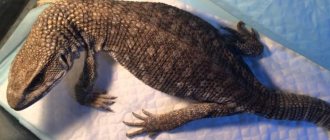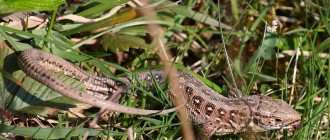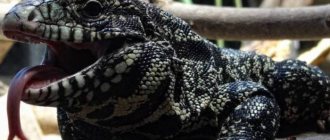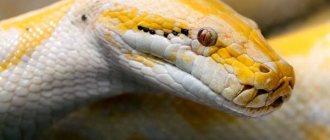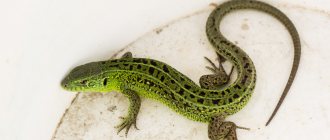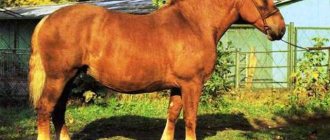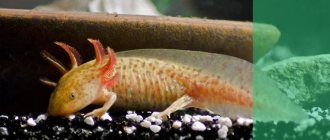- Wild animals
- >>
- Reptiles
The Nile monitor lizard was highly respected by the ancient Egyptians; moreover, they even worshiped these animals and erected monuments to them. Today, the reptile plays an important role in the life and everyday life of the peoples of the northern part of the African continent. Monitor lizard meat is often eaten, and the skin is used to make shoes. Monitor lizards are hunted using fishing lines and hooks, and pieces of fish, meat, and fruit are used as bait.
Origin of the species and description
Photo: Nile monitor
The Nile monitor lizard (Lacerta monitor) was first described in detail back in 1766 by the famous zoologist Carl Linnaeus. According to the modern classification, the reptile belongs to the order Squamate and the genus “Lizards”. The Nile monitor lives in the central and southern regions of the African continent, including Central Egypt (along the Nile River) and Sudan. Its closest relative is the steppe monitor lizard (Varanus exanthematicus).
Video: Nile monitor
This is a very large species of monitor lizard, and is also one of the most commonly found lizards throughout Africa. According to zoologists, the Nile monitor lizard began its spread across the continent many millennia ago from the territory of Palestine and Jordan, where its oldest remains were discovered.
The color of monitor lizards can be either dark gray or black, and the darker the color, the younger the age of the reptile. Patterns and dots of bright yellow are scattered throughout the back, tail and upper limbs. The belly of the monitor lizard is lighter - yellow in color with many dark spots. The body of the reptile itself is very strong, muscular with incredibly strong paws armed with long claws that allow animals to dig the ground, climb trees well, hunt, tear prey apart and defend themselves from enemies.
Appearance and features
Photo: Greater Nile monitor
As already mentioned, young individuals of this species have a darker color in comparison with adult monitor lizards. One could even say that they are almost black, with rather bright transverse stripes of yellow small and large round spots. On the head, they have a characteristic pattern consisting of yellow specks. Adult monitor lizards are greenish-brown or olive in color with transverse stripes of yellow spots that are duller than those of juveniles.
The reptile is very closely connected with water, therefore it prefers to live on the banks of natural bodies of water, from which it very rarely moves. When a monitor lizard is in danger, it does not flee, but usually pretends to be dead and can remain in this state for quite a long time.
The body of adult Nile monitor lizards usually has a length of 200-230 cm, with almost half of the length coming from the tail. The largest specimens weigh about 20 kg.
The lizard's tongue is long, forked at the end, and has a large number of scent receptors. To facilitate breathing while swimming, the nostrils are located high on the muzzle. The teeth of young individuals are very sharp, but with age they become dull. Monitor lizards in the wild usually live no more than 10-15 years, and in places near populated areas their average age does not exceed 8 years.
Where does the Nile monitor live?
Photo: Nile monitor in Africa
The homeland of Nile monitor lizards is considered to be places where there are permanent bodies of water, as well as:
- rainforests;
- savannas;
- bouche;
- undergrowth;
- swamps;
- edges of the deserts.
Monitor lizards feel quite well on cultivated lands near populated areas if they are not persecuted there. They do not live high in the mountains, but are often found at an altitude of 2 thousand meters above sea level.
The habitat of Nile monitor lizards extends from the upper Nile across the entire African continent with the exception of the Sahara and small deserts in Namibia, Somalia, Botswana, and South Africa. In the tropical forests of Central and West Africa, it overlaps somewhat with the range of the ornamental monitor lizard (Varanus ornatus).
Not so long ago, at the end of the twentieth century, Nile monitor lizards were discovered in Florida (USA), and already in 2008 - in California and in the southeast of Miami. Most likely, the lizards were released into the wild in such an unusual place by accident - due to the fault of careless and irresponsible lovers of exotic animals. The monitor lizards quickly acclimatized to the new conditions and began to disrupt the previously established ecological balance, ruining the clutches of crocodiles' eggs and eating their newly hatched young.
What does the Nile monitor eat?
Photo: Nile monitor in nature
Nile monitor lizards are predators, so they can hunt any animal that they have the strength to handle. Depending on the area, age and time of year, their diet may vary. For example, during the rainy season these are mostly mollusks, crustaceans, amphibians, birds, and small rodents. During the dry season, carrion predominates on the menu. It has been noticed that monitor lizards often commit cannibalism, but this is characteristic not of young, but of adult individuals.
Interesting fact: Snake venom does not pose a danger to these reptiles, so they successfully hunt snakes.
Young monitor lizards prefer to eat mollusks and crustaceans, while older monitor lizards prefer arthropods. This preference in food is not accidental - it is caused by age-related changes in the structure of the teeth, as over the years they become wider, thicker and less sharp.
The rainy season is the best period for Nile monitor lizards in terms of obtaining food. At this time, they hunt with great enthusiasm both in water and on land. During drought, lizards most often lie in wait for their potential prey near a watering hole or simply eat various carrions.
Interesting fact: It happens that two monitor lizards team up to hunt together. The role of one of them is to distract the attention of the crocodile guarding its clutch, the role of the other is to quickly destroy the nest and run away with the eggs in its teeth. Monitor lizards also use a similar model of behavior when destroying bird nests.
Now you know what to feed the Nile monitor lizard. Let's see how he lives in the wild.
Breeding
Monitor lizards do not form permanent pairs or communities, preferring an isolated lifestyle. They become zealous defenders of their territory, into which other relatives are not allowed. They perceive representatives of their own species as potential enemies. Under these conditions, monitor lizards group together exclusively at the time of reproduction to conceive offspring.
They mate in the summer. Between May and August, males try to win females and territory from each other. Brutal fights often end in the death of the opponent. The winner of such a fight begins to court the female and forms a pair with her. In September, females begin to lay eggs.
Features of character and lifestyle
Photo: Nile monitor
Nile monitors are excellent hunters, crawlers, runners and divers. Juveniles climb and run much better than their adult counterparts. An adult lizard can easily overtake a person at a short distance. When monitor lizards are chased, in most cases they seek refuge in the water.
Under natural conditions, Nile monitor lizards can remain underwater for an hour or even more. Similar experiments with reptiles living in captivity have shown that their immersion under water lasts no more than half an hour. When lizards dive underwater, their heart rate and blood pressure drop significantly.
Reptiles lead a predominantly diurnal lifestyle, and at night, especially when it gets cool, they hide in termite mounds and burrows. In warm weather, monitor lizards can remain outside, dozing in the water, half-immersed in it, or lying down on thick tree branches. For housing, reptiles use both ready-made burrows and those dug with their own hands. Basically, lizards' homes (burrows) are located in semi-sandy and sandy soil.
Interesting fact: The monitor lizard's hole consists of two parts: a long (6-7 m) corridor and a fairly spacious living chamber.
Nile monitors are most active during the midday and first couple of hours of the afternoon. They really enjoy sunbathing at various elevations. They can most often be seen basking in the sun, lying on rocks, on tree branches, or in water.
Males control areas of 50-60 thousand square meters. m, and for females 15 thousand square meters is enough. m. The males, barely hatched from the eggs, begin with very modest lands of 30 square meters. m, which they expand as they grow older. The borders of monitor lizards often overlap, but this rarely leads to any conflicts, since common territories are usually located near water bodies.
Keeping at home
The Nile monitor lizard has a rather aggressive, hostile character and can inflict quite painful blows with its tail, limbs, and also bite strongly. In addition, he is difficult to train and requires the creation of special conditions. Because of this, experts do not advise novice lovers to have such a pet.
Find out how snakes differ from lizards.
Terrarium
Since the reptile has quite impressive dimensions, it will need a terrarium of the appropriate size. A spacious horizontal tank with a minimum volume of 75 liters is suitable for it.
As the monitor lizard grows, the size of the terrarium must be increased. As a substrate, experts advise using ordinary soil, sand, pine sawdust, orchid bark or artificial turf, which are laid in a thick enough layer so that the lizard can satisfy its needs for digging holes.
It is recommended to equip the terrarium (in order to imitate natural conditions) with tree trunks, driftwood, stones, logs and, of course, a spacious swimming pool.
The water in the pool should be at such a level that the reptile can completely immerse itself in it.
Also, the lizard's housing should be zoned. In one of the zones it is necessary to organize a place for taking warm baths with a temperature in the range of +45-50°.
Daytime temperatures in the terrarium should not fall below +27-32°, and at night they can be reduced to +25-26°.
Make sure that the humidity level in the tank is 60-70%.
Important! Monitor lizards like to relieve their natural needs in an aquatic environment, so the water in the pool should be changed daily. Nobody has canceled safety precautions yet.
Another important aspect of keeping a Nile monitor lizard is the presence of sufficient ultraviolet radiation, which helps prevent various diseases of the musculoskeletal system in the reptile, as well as strengthen the immune system.
To organize lighting, it is necessary to use additional UV illuminators with an emission spectrum of 8.0 units.
Diet
Since monitor lizards are prone to overeating (and, as a result, to obesity), their diet should be based on eating a small amount of food rodents.
At home, reptiles are fed with live food: crickets, zoophobes, small rodents, low-fat fish, eggs.
The lizard's menu is regularly supplemented with special vitamin supplements and minerals necessary for its full growth and development.
Vitamins are given once a week, calcium - once every 10 days.
Cleaning
Since Nile monitor lizards very often soil the water in the pool with feces, it must be changed regularly to prevent the proliferation of pathogenic bacteria.
You should also systematically clean the terrarium of food debris, reptile waste products and other debris.
Unsanitary conditions in a monitor lizard's home can provoke the development of various ailments and lead to deterioration in health.
Precautionary measures
Since the monitor lizard has a rather hostile character, when caring for it you should adhere to certain safety measures:
- It is not recommended to pick up a monitor lizard without special protective equipment;
- you cannot feed the reptile by hand;
- animals that have been caught in the environment must be quarantined and checked for parasites;
- for home keeping, it is better to choose young reptiles: the older the individual, the more difficult it is to tame, and the more aggressive it is;
- During the cool winter and hot summer seasons, it is recommended that the pet be provided with a period of rest.
The Nile monitor lizard is a rather unusual and interesting reptile, which, with proper care and compliance with basic maintenance rules, can become a real pet for adults and children. However, you need to remember that the lizard is aggressive, so when contacting it you must take precautions.
Social structure and reproduction
Photo: Baby Nile monitor lizard
Puberty in reptiles occurs at 3-4 years. The mating season for Nile monitor lizards always begins at the end of the rainy season. In southern Africa this occurs from March to May, and in the west from September to November.
To gain the right to continue the race, sexually mature males organize ritual fights. At first they look at each other for a long time without attacking, and then at some point the one who is more skillful jumps on the opponent’s back and presses him to the ground with all his might. The defeated male leaves, and the winner mates with the female.
For their nests, females most often use termite mounds located near water bodies. They unceremoniously dig them up, lay their eggs there in 2-3 batches and are no longer interested in the further fate of their future cubs. Termites repair the damage and the eggs mature at the right temperature.
Interesting fact: In one clutch, depending on the size and age of the female, there can be 5-60 eggs.
The incubation period for monitor lizard eggs lasts from 3 to 6 months. Its duration depends on environmental conditions. Monitor lizards that have just hatched from eggs have a body length of about 30 cm and a weight of about 30 g. The babies' menu initially consists of insects, amphibians, and slugs, but gradually, as they grow up, they begin to hunt larger prey.
Nutrition
Komodo dragons are carnivores, which means they only eat meat. Since this huge monitor lizard is the dominant predator on a limited handful of islands, it will eat anything, including carrion. Their menu includes deer, pigs, buffalo and smaller lizards. They will not miss their young fellow tribesmen, thus being real cannibals. Young monitor lizards feed mainly on small lizards, geckos, snakes, birds and insects.
Giant monitor lizards use a rather original method of hunting. First, they start tasting well before dinner starts. They are helped in this by their unique forked tongue, with which they seem to taste the air, and with the help of special organs of the mouth they analyze air molecules. Thus, monitor lizards sense the taste of the victim, who may be several kilometers away from them at that time. And the sensitivity of the forked tip of the tongue suggests the location of the future lunch. So, if the concentration of prey odor molecules is greater on the left side of the tip of the tongue, then the monitor lizard knows: it needs to look for prey on the left. This feature, plus an undulating gait, in which the head swings from side to side, helps them sense the existence and direction of the fall even 4 km away. But only if there is a fair wind.
When stalking their prey, they rely on their patience and camouflage body color. When an unwary prey is nearby, the monitor lizard's job is to knock the victim off balance, sometimes breaking its legs with its powerful paws and tail. If the prey is small, then the predator rushes straight at its neck. If at this moment the prey tries to escape, then this giant will tear it apart until it stops moving. Only then will he release the victim for a short time and deliver the final fatal blow: he will rip open the belly and thus bleed the prey. Only then will he begin the long-awaited meal.
Those animals that managed to escape from the mouth of Komodo dragons will not be happy for long. The saliva of monitor lizards is simply teeming with bacteria, of which there are more than 50 different strains. In addition, these large reptiles have venom glands in their lower jaws. During an attack on a victim, they secrete a secretion containing a toxic protein, which leads to impaired blood clotting, decreased blood pressure and body temperature, muscle paralysis and excruciating pain. A creature affected by this poison is destined to die in the coming days from blood poisoning. The predator's keen sense of smell helps it travel many kilometers, following its prey, waiting for the bacteria to complete their work.
If a lizard's bite is fatal to all surrounding animals, then for another Komodo dragon it will not be so dangerous. And injuries during clashes between brothers often occur, especially during the mating season. Scientists are currently testing the blood of this large lizard in search of antibodies that will help save attack victims in the future.
The largest lizard in the world is the Komodo dragon
Large carnivores such as lions and tigers typically leave behind up to 30% of the animal they kill. Typically this includes the skeleton, hooves, skin and intestines. Komodo dragons will hardly leave behind 12% of their prey. Their stomachs are capable of digesting skeletons, hooves, and skins. They can even eat the intestines, but only after emptying it of all its contents.
Natural enemies of Nile monitor lizards
Photo: Nile monitor in Africa
The natural enemies of Nile monitor lizards can be considered:
- birds of prey (hawk, falcon, eagle);
- mongooses;
- cobra
Since lizards are immune to even very strong snake venom, the cobra often turns from enemy into prey and is safely eaten from head to tip of tail.
Also, monitor lizards of this species, especially recently hatched young animals, are quite often hunted by Nile crocodiles. Older individuals, apparently due to their life experience, are much less likely to become victims of crocodiles. In addition to hunting, crocodiles often take the easier route - they destroy the egg clutches of monitor lizards.
To protect themselves from most enemies, Nile monitor lizards use not only their clawed paws and sharp teeth, but also their long and strong tail. In older individuals, characteristic deep and ragged scars can be seen on the tail, indicating its frequent use as a whip.
There are also frequent cases when birds of prey, having grabbed a monitor lizard not very successfully (leaving the head or tail free), themselves become their prey. Although, having fallen from a great height during such a fight, both the hunter and his prey usually die, subsequently becoming food for other animals that do not disdain carrion, thus participating in the cycle of life in nature.
Population and species status
Photo: Nile monitor in nature
As already mentioned, Nile monitor lizards among the peoples of Africa have always been considered sacred animals worthy of worship and the construction of monuments. However, this has never stopped and does not stop people from exterminating them.
The meat and skin of the monitor lizard is of greatest value to the natives of Africa. Due to poverty, few of them can afford pork, beef and even chicken. So you have to diversify your menu with what is more accessible - monitor lizard meat. Its taste is very similar to that of chicken, but it is more nutritious.
The monitor lizard's skin is very strong and quite beautiful. It is used for making shoes, bags, and other accessories. In addition to the skin and meat, the internal organs of the monitor lizard are of considerable value, used by local healers for spells and treatment of almost all diseases. In America, where monitor lizards arrived at the suggestion of exotic lovers, the situation is the opposite - a rapid increase in the population was recorded, since it is not customary to hunt them there.
In the first decade of the 2000s, in northern Kenya, a population density of monitor lizards of 40-60 individuals per square kilometer was recorded. In the region of Ghana, where the species is very strictly protected, the population density is even higher. In the Lake Chad area, monitor lizards are not protected; hunting for them is allowed, but at the same time, the population density in this area is even higher than in Kenya.
Possible ailments
Monitor lizards often suffer from stomatitis. The onset of the disease can be judged by the unpleasant odor from the mouth. The manifestation of the disease is accompanied by tissue death. The reason for this is improper nutrition or incorrectly set temperature conditions in the terrarium. You can cure your pet by changing its diet. Eating a balanced diet will allow the animal to heal. Wounds are treated with creams.
Monitor lizards often suffer from obesity. Fat deposits accumulate on the tail and belly. The reason for their appearance is overfeeding the pet. The monitor lizard needs to be put on a diet.
Another disease that may develop in animals is gout. It occurs due to lack of water or poor nutrition. With this disease, swelling of the joints is observed. A sick monitor lizard needs to reconsider its diet. In addition, there should always be fresh water in the terrarium; this is a prerequisite.
